Hungarian Secession
In the latter half of the 19th century, following the restructuring of the Habsburg Empire, Hungary embarked on the most prosperous chapter of its history. Architecture especially thrived during this era, and the newly unified Budapest acquired the grandeur that, despite its later hardships, continues to secure its place as one of the most beautiful cities in the world to this day. Imagine the impression this city must have left on visitors over a century ago – a city boasting the world’s largest parliament building, the largest synagogue, the oldest continental metro, railway stations, public edifices, bridges, and more.
A particular marvel of this period, which continues to captivate visitors to this day, was the wealth of architecture in the style of Secession, as Art Nouveau was known in Hungary. This unique and profoundly revolutionary artistic movement swept across Europe at the turn of the 20th century. Nowhere, except perhaps in Catalonia, was this style embraced with as much enthusiasm and public support as in Hungary. Hungarian architects adorned their buildings not only with unusual, floral, and rounded forms but also, with great patriotic fervour, with decorations drawn from the nation’s folk traditions. The most frequent motifs were stylized Székely ornaments from the mythologized Transylvania. However, at times, the architects emphasized Hungary’s Eastern origins, leading to the use of Middle East and even Indian motifs, albeit historically unfounded. Regardless of the source of inspiration, Hungarian architects masterfully blended Art Nouveau with national romanticism, bestowing Hungary’s cities with a brilliance that has never since been surpassed. This golden age of architecture extended beyond the borders of present-day Hungary: the cities in Transylvania, as well as the city of Subotica, and especially the nearby leisure lake resort of Palić, were imbued with charm and splendour.
The Hungarians particularly revere the architect Ödön Lechner, referring to him as the founder and most important representative of the style. However, the works of his followers were equally successful. Among them, Béla Lajta, Ede Magyar, who was active in Szeged, and the creative duo Marcell Komor and Dezső Jakab, the authors of the most significant buildings in Palić and Subotica, stood out. It is worth noting that some of the architects who defined Hungarian Secession were our compatriots, born in Vojvodina. The most prominent among them were Gyula Pártos, the professional and creative partner of Ödön Lechner, and Ferenc Raichle, perhaps the most talented architect of Hungarian Secession, both born in Apatin. Today, they are the pride of the nation and are celebrated throughout Hungary.
Architecture in Difficult Times
The end of World War I and the collapse of the Austro-Hungarian Monarchy brought a swift and brutal halt to this prosperous period. Overnight, Hungary shrank into a small and insignificant country, grimly earning the title of world champion in suicide rates. First under the shadow of Nazi Germany and later under the iron grip of Soviet Russia, Hungary found itself in not exactly ideal companions for fostering creativity. Unsurprisingly, its architecture stagnated, with architects churning out designs dictated by the whims of ideologically driven and politically dominant neighbours.
For years, Imre Makovecz was just another cog in this machine, quietly honing his skills by designing whatever was demanded of him. But in the early 1980s, as the grip of communism loosened slightly, Makovecz broke free. Establishing his own firm, he began creating designs unlike anything he had done before. It was in a reimagined form that his bold, visionary structures dragged Hungarian Secession out of the shadows of nostalgia and back into the spotlight. While regime officials frowned and raised sceptical eyebrows, the general public embraced him with genuine enthusiasm. Makovecz’s work ignited a spark of hope, a glimmer of a return to Hungary’s once-brilliant architectural legacy.
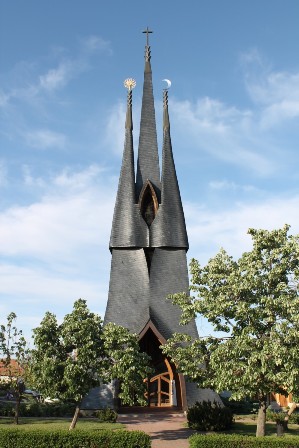
The Reawakening of Hungarian Architecture
A few years later, the political regime underwent a thorough transformation, and Hungary was handed a new historical chance. The newly emerged democratic Hungary was far from being a bastion of cosmopolitan liberalism. On the contrary, it proved to be a deeply conservative country that believed in God and traditional values, enthralled by a mythologized history and glorified heroes of the past. It may not have been the most inspiring climate, but after decades of lethargy, it was enough to stir Hungarian architecture from its long slumber. Naturally, given his already established reputation, Mr Makovecz became something of a national hero and a cherished figure of this reawakened Hungary.
By then, he had fully developed his distinctive style, which not only revived Hungarian Secession but also modernized it. He simplified its decorative elements and enriched it with the dynamic forms of organic architecture. At the heart of Makovecz’s designs were his signature tree-like concrete columns, where “branches” extended with structural precision to reduce the spans of beams and arches, while the branches themselves were subjected almost only to compressive forces, efficiently and logically channelling them to the “trunk”.
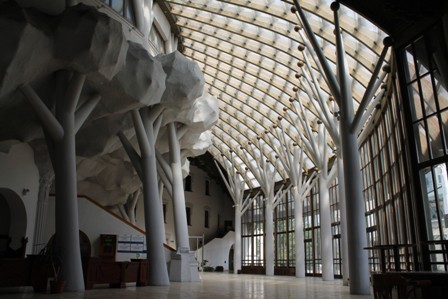
The roof structures in Makovecz’s buildings are always wooden, most often made of laminated wood arches, which he carefully crafted to shape the buildings in accordance with their function and location. He also had a few favourite decorations, some of them rather peculiar, which recur in many of his structures. One of his frequent motifs is a pair of wings – likely angelic wings—reflecting his deep personal faith. Remarkably, Makovecz not only believed in God but also in angels. In some instances, such as the Roman Catholic Church in Paks or the Reformed Church in Cluj, Makovecz drew inspiration from the Secessionists, incorporating symbols like the crescent moon and the Hindu sun. These elements evoke the mythical “East” in its broadest sense, the ancestral homeland from which the Hungarian tribes are believed to have originated.
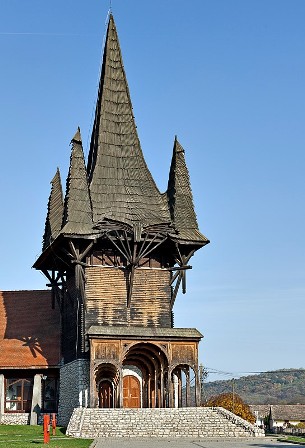
Given his stature in post-communist Hungary, Mr Makovecz had the privilege to choose his projects. If he had wished, he could have easily secured commissions to design landmark state buildings in central Budapest, where millions of tourists and influential foreign architectural critics would have seen his work. Instead, he chose a different path – to craft structures in the villages and small towns of rural Hungary, the very places that inspired his aesthetic. In these small Pannonian towns, his creations are the main attractions, leaving the most profound impression when they are stumbled upon unexpectedly, without prior planning or preparation.
His designs, often churches, cultural centres, and spa facilities, adorn little-known towns scattered across the Hungarian plains, the places few outside Hungary have ever heard of: Sárospatak (literally “Muddy Stream”), Kakasd (roughly “Rooster’s Place”), Piliscsaba, Siófok, Százhalombatta, and occasionally towns abroad where Hungarians live, most often in Transylvania.
In some towns, he was entrusted with designing nearly all major public buildings, giving these places a distinctive and cohesive character defined by his unique aesthetic. Such is the case with towns like Csenger and Sárospatak, and especially the town of Makó. Known for its spa and proximity to the Serbian border, Makó is familiar to many of our compatriots.
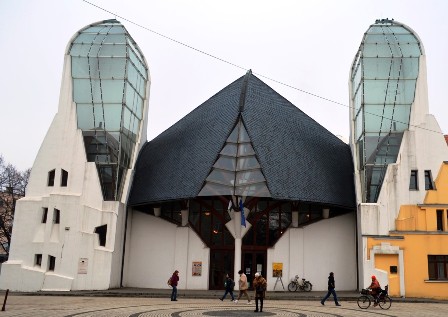
In Makó’s central city hotel, you can even receive guidance for a “Makovecz Tour,” showcasing the structures he designed in the city, including the theatre, the bus station, and the spa facilities. In line with his organic principles, Makovecz drew inspiration from Makó’s renown for onion production. This influence is prominently reflected in the design of the theatre and the “Hagymatikum” spa (hagyma meaning onion in Hungarian), where the motif became a central element.
Despite the fact that many of his works are located in remote areas seldom visited by foreigners, Imre Makovecz’s distinctive and extensive oeuvre has garnered significant recognition within the international architectural community. His work is celebrated as a prime example of consistent organic architecture. Over his illustrious career, Makovecz received numerous awards and was a member of some of the world’s most prestigious architectural associations. In Hungary, his influence extended beyond architecture – he founded the Hungarian Academy of Arts, served as its lifetime president, and lent strong support to conservative political parties.
As an illustration of the importance of his oeuvre to the Hungarian public, it is worth mentioning that a bizarre conspiracy theory emerged around his persona. According to this outlandish claim, Makovecz was a satanist, and his buildings are allegedly filled with inverted crosses, Horus wings (thus, not angelic ones), and other pagan occult symbols. What an honour. After all, is there any greater recognition than being declared a satanist by envious locals?
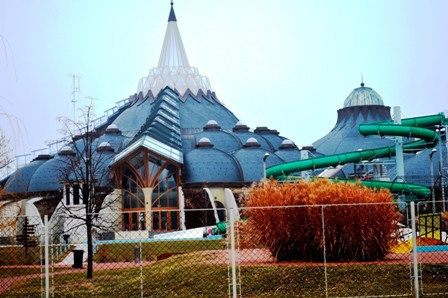
Naturally, restoring Hungarian architecture to its former glory is not a task for a single individual. Imre Makovecz did all he could, but it is now up to others to follow the path he blazed. If we draw a historical parallel and regard him as the Ödön Lechner of a new era, the question remains: who will be the next Ferenc Raichle? And will the 21st century see the emergence of a creative duo akin to Jakab and Komor of the past?
Darko Veselinović
November 2017



